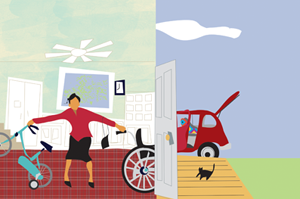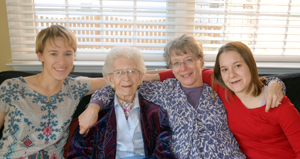Chris St. Clair’s mother was firmly rooted in Breckenridge, Texas, population 6,000, with its three traffic lights and two grocery stores. She had graduated from the local high school and knew how many times the banks had changed names. She didn’t intend on leaving.
But in 2009, the 82-year-old woman’s weight dropped to 83 pounds. When a home nurse called to tell St. Clair, the Kensington resident jumped on a plane to Texas.
There, she found her mother’s refrigerator and pantry near empty. She learned that her mother had canceled Meals On Wheels, which had been delivering lunches and dinners, and that she had been driving around town against her doctor’s orders while recovering from cataract surgery.
“She was doing things that were going to cause her to die,” St. Clair says.
Seven times that year, St. Clair had flown to Texas to arrange her mother’s surgery, along with Meals On Wheels and a nurse to check in regularly. With a husband, two daughters and a full-time job setting up computer systems, it wasn’t easy, and St. Clair quickly ran through her annual leave. Still, she was confident that she had created a stable and comfortable environment for her mom.
Now she was back in Texas, throwing her mother’s clothes into a suitcase in order to move her to Maryland. St. Clair wasn’t sure how it would work out; she just knew that she needed her mother closer.
That’s how Chris St. Clair became a member of the sandwich generation, the growing group of people who find themselves caring simultaneously for their children and for their parents. It’s a societal matter that can be traced to two trends: longer life spans, and the decision by couples to become parents later in life, not long before their parents begin needing care, too.
By 2030, 18 percent of the population will be over age 65, up from 13 percent in 2010, according to the Pew Research Center. The toll on the sandwich generation can be substantial, draining their time, finances and emotions, experts say. Many begin to neglect their own needs and sink into depression.
Some find the best answer is to relocate their parents and incorporate them into their own lives. In St. Clair’s case, that meant cleaning out and selling the family home, finding a good, affordable living arrangement for her mother near Kensington, signing up new doctors and establishing a support system that included transportation.
St. Clair’s neighbor, Annie Hayes, chose a different path. She and her siblings take turns having their mother stay in their homes. And in Bethesda, Maria Jimenez did the opposite: She moved her own family across town and into her mother’s house.
Others do what they can long-distance. Kathleen Hall’s parents are in Kentucky, and she tries to get there once a month for a long weekend. She also spends four to six hours a week trouble-shooting from her home in Kensington. Her mother is in the early stages of dementia, and in 2010 her father lost the use of his legs after surgery to replace a heart valve.
“Within a three-week period, he went from being caregiver to needing 24-hour care,” Hall says.
Her parents now live separately: Her mother is in an assisted living facility, and her father receives in-home care.
Hall belongs to a support group that meets over coffee after Sunday services at St. Luke’s Episcopal Church in Bethesda to exchange how-tos on everything from establishing power of attorney to finding in-home care providers.
“I’ve thought about bringing them here,” Hall says of her parents. But “it felt almost cruel to do that.” Both have extended families in Kentucky, including sisters, grandchildren, nieces and nephews. Alzheimer’s experts have advised against moving them, she says. “Uprooting someone at this stage, they said, is incredibly traumatic.”
Leaving the old and the familiar can be devastating to many seniors, says Nancy Wesson, author of Moving Your Aging Parents (Loving Healing Press, 2008). There’s even a name for it: Relocation Stress Syndrome, which can be triggered by a simple move across the hall, she says.
The toll isn’t only emotional. There can be changes in blood pressure, loss of appetite, aches, pains and other problems. “They literally stop eating. They get depressed, anxious. These are real symptoms,” Wesson says.
Richard Birkel, a psychologist and vice president at the National Council on Aging in Washington, D.C., says people who are frail or suffer from dementia are particularly at risk. “For some people, it is extremely stressful to change,” he says. “For very vulnerable people, this may be the push over the cliff.”
But for others, moving can be a positive experience. “We’re seeing a lot of seniors moving back to their home communities when health care needs become a priority for them,” Birkel says. “…It can be a blessing when a family has the opportunity to re-establish close relations.”
Experts advise discussing relocation options—along with long-term care insurance and plans for power of attorney—before elderly parents have any serious mental impairment. And once a move is imminent, they say, place as many decisions as possible in parents’ hands.
Alyssa Sanders, a social worker and actress who lives in Kensington with her daughter, is planning to relocate her mother from Tamarac, Fla., this year. “I’d like to move her before it’s too difficult,” Sanders says. Her mother is 83 and has diabetes, macular degeneration and a blood cancer that’s in remission.
Overall, she’s fine on her own, but she can’t manage the little things anymore. “They’re calling you and they need you to change the clock on the wall, and you can’t do it — and she’s so afraid to spend money [that] she won’t pay a handyman to come in,” Sanders says.
Dealing with that will be easier if her mother is closer. And by moving her now, Sanders says, her mom will be able to choose an apartment, decorate it as she likes and build a social life.
Making small decisions such as those can mean the difference between excitement over a new living situation and rapid decline, Wesson says.
What furniture should they take? Which photos and candy dishes are meaningful? Would they be better off in a cozy group home or a larger facility with lots of activities, one that can take them from independent living to nursing care if necessary?
St. Clair found clearing out the old house in Texas to be the easiest part of the transition. Sure, there were mountains of inconsequential items to dispose of: 10 cans of insect repellant and more Pledge than she could ever use. The harder decisions were about furniture and personal items.
St. Clair took photos to help her mother decide. Two years later, much of the furniture that wouldn’t fit into her mother’s new apartment is crammed into St. Clair’s dining room and garage.
Robert Ray of Silver Spring is in the business of helping the elderly move. A former pastor, he’s president of Caring Transitions in Silver Spring, a franchise with locations in 42 states.
Recently he helped a woman relocate her mother from New York City to Chevy Chase. The New York staff conducted an inventory of her belongings and then created floor plans of both the old and new apartments in order to see what furniture would fit where.
When the elderly woman walked into her Chevy Chase apartment for the first time, it looked familiar. “We tried to position everything from the tables to the pictures in their same locations,” says Ray, who also conducts estate sales and hires cleaners.
Sometimes Ray finds himself back in his previous counseling role. All too often, he says, adult children forget that they need to focus on their parents’ wishes.
“As long as a parent is still alive and can articulate, I pay attention,” he says. “It’s what Mom or Dad has to say that matters.”
Where elderly parents end up — whether in an adult child’s guest room, a nearby apartment, a senior community, a group home, an assisted living facility or a nursing home—is an intensely personal decision, experts say. And finances play a big role.
In 2010, half of those 65 and older had incomes of less than $22,000 a year, and half had less than $53,000 in savings, according to the Kaiser Family Foundation. Meanwhile, the average annual cost of nursing home care today is $72,000; assisted living, $38,000; and home health care services can total $30,000 a year, according to LifePlans, a long-term care insurance services, risk management and research company.
More than 10 million Americans currently need long-term care, according to the foundation, although few people purchase long-term care insurance. Medicaid, the health care program for the poor, pays for 40 percent of all long-term care. The 2010 health law will expand Medicaid coverage beginning in 2014 so that individuals with annual incomes of roughly $14,000 or less will qualify.
Medicaid, which is financed jointly by the federal government and individual states, used to pay only for nursing home care, but now sometimes covers care in assisted living facilities and in the home.
Adult children taking care of aging parents also incur significant expenses. The annual cost to long-distance caregivers is $8,728, compared with $5,885 when they live under the same roof, according to a 2008 AARP report. Caregivers who spend the least—$4,570 a year—live close to, but not with, their parents.
Finding the right situation can be a matter of trial and error. St. Clair moved her mother in with her, but with a full-time job, she found it difficult to keep up with the elderly woman’s needs. Her mother had high blood pressure, high cholesterol, glaucoma and moderate Alzheimer’s.
Before long, St. Clair was looking for another situation. She called Seabury Resources for Aging, a nonprofit organization in northwest Washington, D.C., that helps locate geriatricians and housing and financial planners, in addition to driving seniors to doctors appointments. It charges on a sliding scale, anywhere from $3 to $110 an hour.
Seabury connected St. Clair with Mary’s House, an assisted living community in Rockville. That’s where her mother lives today.
Across the street from St. Clair, Annie Hayes is taking a less conventional approach. She and her five siblings move their 88-year-old mother from house to house, but it has been harder than Hayes imagined. Her mother needs to have someone with her full time. She’s unstable on her feet and began suffering dementia after her husband died two years ago.
For five weeks at a time, Hayes’ retired brother lives with their mother in a retirement community in Lewes, Del. Then he heads home to Michigan for five weeks, and their mother starts making the circuit. She spends a week with each of her five other children. Then it’s back to Lewes.
She was with Hayes and her husband earlier this year. Because they both work, they explored bringing in a companion during the day. “She was lonely,” Hayes says. “It doesn’t turn out to be what you expect. Your life is organized, and you think Mom will fit into that, but it’s a whole new puzzle you have to figure out.”
Now the siblings are considering spending their designated weeks with their mother in Lewes. They think she will need an assisted living facility at some point, but there are financial challenges. “Right now, everybody is pitching in,” Hayes says, “but when it comes to writing checks—and it hasn’t gotten to that point yet—that’s going to be very tough. Everybody has money problems right now.”
Several years ago, Maria Jimenez moved her own family across town and into her now 80-year-old mother’s house in Bethesda. Jimenez no longer works, but she used to be responsible for quality assurance at the Kensington Nursing and Rehabilitation Center. She recalls a Cuban woman with dementia whose daughter moved her to the facility from Florida. The woman couldn’t communicate easily with the English-speaking staff, and she missed the foods to which she was accustomed.
“When people reach that age, everything is simplified,” Jimenez says. “What makes you happy are just the simple things, like making sure they get the cuisine they love, seeing familiar faces, like the mailman or the lady across the street.
“That’s what some of these families are struggling with—plucking the loved one out of the environment that they chose to live in. This lady had gone to Florida to retire there, to be closer to friends, and here they are having to pluck her back out. It was for the right reasons—to care for her—but for the senior, it wasn’t always, ‘This is a great thing that they’re doing to me.'”
Eventually the family found her a group home nearby with Spanish-speaking staff. The food isn’t Cuban, but it is Hispanic, and the atmosphere is homier.
“The longer you can keep older adults in a homelike, natural environment, the better it is for them,” Jimenez says. “It doesn’t matter how you sugarcoat it, these are institutions, and there’s a lot that you lose.”
That’s why Jimenez packed up her husband and two children and moved in with her mother after her father died suddenly in 2005. At the time, her mother was healthy, but “the idea of being alone horrified her. … My mother was someone who had grown up in a big family, the more the merrier.”
Her mother’s house was formal and filled with porcelain—not exactly kid friendly. Moreover, the flooring was slippery, which was unsafe for Jimenez’s son, who has cerebral palsy. Her mother agreed to install hardwood floors and switch out some furniture. “Everybody had to give up something. We were giving up our neighborhood,” Jimenez says.
But they’ve gained something, as well. “It’s definitely a different childhood when you have a grandparent involved,” Jimenez says. Since her mother is active, “the kids have positive views on aging. It’s not always about someone who’s completely dependent. I love the idea of my kids growing up seeing a smart, vibrant, sassy grandmother.”
For St. Clair, life is easier since her mother moved to Maryland. Her hope was to keep her job, maintain her family life and still help her mom. She believes she has accomplished that.
Instead of spending time making quick trips and arrangements for her mother’s care, St. Clair can enjoy quality mother-daughter time now. She sees her several times a week, and her mother particularly looks forward to their trips to CVS. “She likes the fact that someone is checking on her,” St. Clair says.
Jessica Marcy contributed to this story.
This article was produced by Kaiser Health News with support from The SCAN Foundation.









